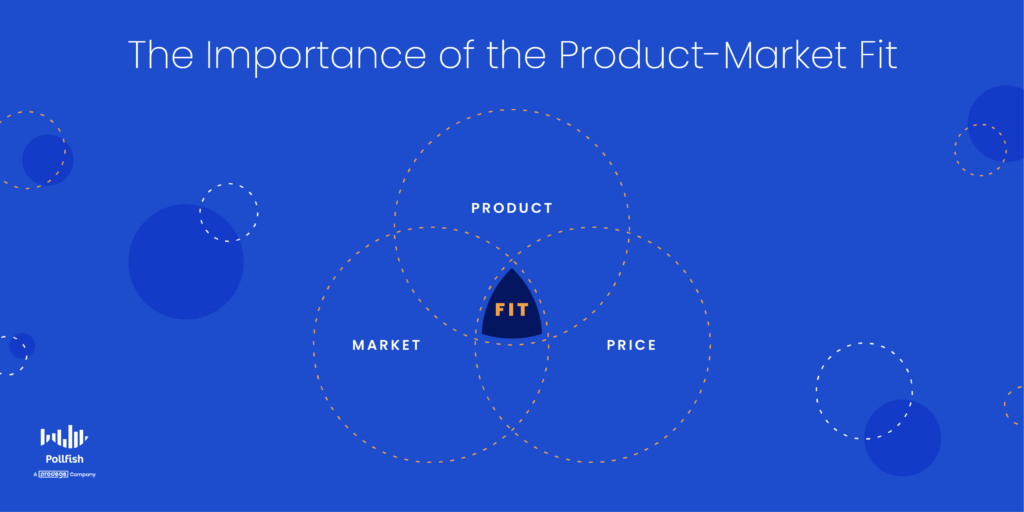What is Product-Market Fit and How You Can Earn it Via Market Research

In an ever-competitive startup world, you need to be able to identify your product-market fit. This concept dictates how well a particular market will respond to your product or service, thus predicting its success.
After all, it would be costly and useless for businesses to launch a product that doesn’t align with current market dynamics and demands.
Marc Andreessen, co-founder and general partner of Andreessen Horowitz, who popularized product-market fit, described the term as “being in a good market with a product that can satisfy that market.”
Moreover, this concept is important to measure and achieve, as a lack of a product-market fit is one of the top reasons why businesses fail. In fact, 35% of new businesses fail due to the lack of product-market fit. On the contrary, a strong fit leads to a high-performing product among its target market.
However, a hefty 80% of SaaS companies never make product-market fit. As such, reaching and measuring this concept for your business can be challenging, but market research helps you both gauge and earn it.
This article examines the concept of product-market fit, its importance, how to measure it and how to obtain and increase it for your business.
What is Product-Market Fit?
Product-market fit, also known as product/market fit, denotes the extent to which a product satisfies a strong market demand. It is typically used to describe startup companies, as long-established businesses have some degree of it — otherwise, they wouldn’t be in business.
In laymen’s terms, product/market fit means being in a good market with a product that can satisfy that market.
This concept describes the stage of a startup company in which it has successfully identified a target market — it therefore also involves the process of first finding a market that will become consumers of your product. This way, the company can serve its members with the right product or service.
When brands achieve a strong product-market fit, they can then work towards scaling; they do so by attracting more customers, usually through market research techniques.
There may be multiple market segments in your product-market fit. It’s important to ascertain at least one when establishing a business or creating a new product.
If you don’t ensure that the product you’re developing aligns with the needs of customer personas, scaling will be difficult.
This concept is also used to depict a scenario in which a company’s target market members are not solely desiring the company’s product or service, but are buying, using, and telling others about the company’s offerings. This phenomenon involves the customers doing this in large numbers, the kind that sustains a product’s growth and profitability.
As such, product-market fit is designed, intended for and is often manifested as something that critically affects customer behavior, mainly in a way that benefits a company.
The occurrence (and maintenance) of a product-market fit exists as a conjunction of three critical aspects:
- Customers recognize your product’s value.
- They tell others about their great customer experience with your product.
- Your business continues to provide an excellent customer experience for new customers.
Although this concept is usually associated with marketing and product management, achieving it is a shared responsibility across the company. This means that sales, business development, support, finance and all other departments can help a company reach this important milestone.
The Importance of Product-Market Fit
Product-market fit is important on several counts.
First off, before you create a product that you confirm enough consumers are willing to use and pay for, your business cannot afford to plan or work on any other strategic objectives. This is because it is impossible to focus on growth if you do not have a customer base or a product deemed viable by your would-be target market.

After all, how can a business cross or upsell if they haven’t sold anything to begin with? Or, even if you had sold some products early on, if you failed to sustain a product-market fit, your chances of sustaining both a customer retention rate and customer acquisition are slim.
As such, any initiatives you take before establishing a product-market fit are counterproductive, as you don’t have enough demand to generate a profit. As such, if you continue working on something with a low product-market fit, or one you haven’t measured, you’re essentially risking investing in something with no commercial value.
In addition, you won’t be able to raise enough seed money, let alone further funding rounds without a sound product-market fit.
Venture capitalists and other debt lenders take a risk on the companies they fund; they will not invest in a company with a low product-market fit. This is because they expect a return on the investment they input into a business. Evidently, there will be no such return if your products don’t yield high enough demand.
When fledgling businesses struggle to raise venture capital, they end up in a startup graveyard, unable to launch their business, all due to the market for a product not being big enough, also known as a low product-market fit. Even the “good” entrepreneurs can wind up on this graveyard when they unintentionally chose to create products for small, crowded, or shrinking markets.
A product-market fit is especially important for B2B SaaS startups, as there is much they contend with, such as educating their markets on the benefits of their products — which takes time and money. They also face the pressure of accelerating their sales from venture capitalists.
It is therefore par for the course that startups need 2-3 times longer to validate their product-market fit than their founders expect.
How to Measure Product-Market Fit
You can determine your product-market fit in a number of ways. Determining your product-market fit involves the process of adjusting the product in your market based on consumer feedback, and using that feedback to evaluate its profitability.
This process verifies that you have established a group of potential customers that react positively to your service or product. This ensures that it is auspicious enough for you to sell it.
As such, product-market fit is less concerned with crunching numbers and more focused on understanding who your customers are in-depth and how they feel about you and your offerings.
Measuring product-market fit therefore involves gauging the following:
- The need for your product or service
- The level of satisfaction of your customers (and those of competitors)
- The level of engagement with your products and services
- How often your customers use your product and services
- How many new users (or customers) you get through word of mouth
- The purchase frequency of your products or those in your niche
In all of these cases, market research can provide accurate answers from your target market or your market under study.
To measure your product-market fit, use the 40% rule, made popular by Sean Ellis. This is a conventional metric for making sense of product-market fit survey results.
This rule dictates that a business holds an adequate amount of product-market fit if at least 40% of customers surveyed say they would be “very disappointed” if they no longer had access to a product or service — or if 40% consider the product/service a “must-have,” meaning, they wouldn’t use an alternative.
You can also apply this rule to the above aspects of measuring product-market fit (in the numbered list). To measure these aspects, you’ll need to conduct primary market research, also through conducting surveys. You can begin by analyzing secondary market research, but the most relevant and up-to-date information you’ll be able to extract on your product-market fit is by surveying potential (and current ) customers yourself.
Do not run this test on just any suspected member of your target market. According to Sean Ellis, the participants of this product-market test must have the following qualifications:
- Consumers who have experienced the core product or the service.
- Consumers who have experienced the product or the service at least twice.
- Consumers who have experienced the product or the service in the past two weeks.
How to Obtain a Product-Market Fit with Market Research
As the previous section explained, the core aspects of a product-market fit can be measured via using surveys and analyzing the responses via the 40% rule. You can also aid your market research with secondary sources.
However, to gain demand and increase your product-market fit, you must constantly listen to the needs, desires, problems and aversions of your target market.
This way, you’ll understand the kinds of products that solve their issues and adapt to their needs, thereby reeling in a high product-market fit.
With this information in tow, you can then confidently and successfully launch your product(s) and even base your business around them.

Surveys allow you to question your target market on virtually anything, along with segmenting it via market segmentation and developing customer personas.
As such, using surveys is a solid market research strategy, giving you speedy insights you can use to make informed decisions. Surveys allow you to not merely gain in-depth data on your consumers, but also allow you to monitor your customers over time — this enables you to measure whether your product-market fit can withstand the test of time.
You can also use survey results to justify your product-market fit to venture capitalists and other lenders. These results provide the definitive proof they would need on the viability of your product.
By regularly conducting survey research on your target market, you’ll be able to better innovate on your products so that they continue driving demand, therefore increasing your product-market fit.
By understanding your target market at a deep level with market research, you’ll also be able to serve it better, therefore pulling demand from your customer experience aside from the product alone.
Targeting Your Most Valuable Consumers
In order for startups and long-standing businesses to survive, they need to have a high product-market fit, which dictates how well a product is in demand in a certain market. Luckily for business owners and market researchers, you can measure and even grow your product-market fit with an online survey platform.
To do so, you’ll need a strong online survey platform to carry out your market research and present it in a way that’s most convenient for you.
You should use an online survey platform that makes it easy to create and deploy consumer surveys. It should offer random device engagement (RDE) sampling to reach customers in their natural digital environments, as opposed to pre-recruiting them.
You should also use a mobile-first platform since mobile dominates the digital space and no one wants to take surveys in a mobile environment that’s not adept for mobile devices.
Your online survey platform should also offer artificial intelligence and machine learning to disqualify low-quality data and offer a broad range of survey and question types.
Additionally, it should also allow you to survey anyone. As such, you’ll need a platform with a reach to millions of consumers, along with one that offers the Distribution Link feature. This feature will allow you to send your survey to specific customers, instead of only deploying them across a vast network.
With an online survey platform that offers all of these capabilities, you’ll be able to quickly extract consumer data and evaluate your product-market fit.
Pollfish Marketing Team
Ready to Try Pollfish?
Create your survey with AI, target high-quality respondents starting at $0.95 per complete, and start getting results in just minutes in real-time. From running a simple product concept survey to managing a constant stream of trackers for dozens of clients in dozens of countries, we’ve got you.
